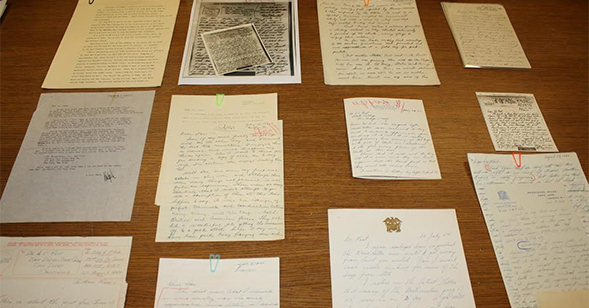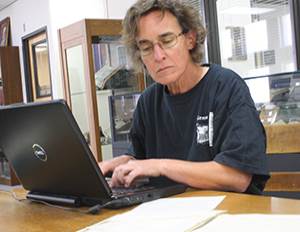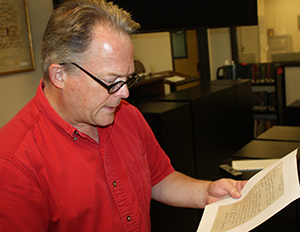D-Day: June 6, 1944
An SDSU Library collection reveals Aztec accounts of storming Normandy Beach.

D-Day: June 6, 1944.
Seventy years ago this month, the United States and its allies launched the largest seaborne invasion in history against the German forces occupying France.
Among the hundreds of thousands of Allied troops that stormed the Normandy beaches and parachuted from planes under heavy fire were dozens of San Diego State alumni and former students. Many of those who survived wrote letters of their experiences and sent them home to update family, friends and fellow Aztec military service members stationed around the world.
One of those was paratrooper Tom Rice (’46), who sent a letter from France dated June 28, 1944. In his own script, he describes parachuting into Normandy in the early hours of the invasion.
“Jumped in Normandy at 1:31 a.m. June 6, D day. The reception which was given us was really torrid. They threw everything at us including the kitchen sink. The sky was lit up as bright as day…”

Rice’s first-hand account of the invasion is one of at least 28 letters specifically referencing D-Day that are part of the library’s World War II Servicemen's Correspondence Collection. The collection contains almost 5,000 letters received from servicemen, servicewomen, and their families during World War II as part of Dr. Lauren Post’s Aztec News Letter project.
A mother lode of information
Robert Ray, head of Special Collections and University Archives, says the letters are important because they provide context for what actually happened during the invasion. The first-person accounts provide a variety of perspectives that can provide scholars with new understandings of different aspects of the historic invasion and of World War II.
"There will be stories that have never been told before and information and understandings of the war that have never been possible because there just isn't that much first-hand writing of the experience itself,” Ray said. “Researchers will unveil that for the rest of us, but I know it's a mother lode of information and possible new insights into the war."
Lisa Shapiro is a Mesa College instructor and war literature researcher who for the past year has been reading the letters in the Correspondence Collection.
"It's invaluable. It's priceless. There are so many different things you can track (through the letters in the collection),” she said. "I believe this is one of the only collections that exists where we can go back and tell the story of World War II from a first-person account.
“These letters are unique in that they're written in the present tense. They're not written as history. They're not filtered. It's not like a memoir where people are looking back. You get a snapshot moment.
“People go on for pages describing what things look and sound and feel like. So from a storytelling perspective, it's unique because so many voices are all describing the war and it captures so much about it."

Reaching researchers
Only halfway through the letters, Shapiro estimates it will be at least another year before she completes her reading of the entire collection. After she finishes, she hopes to write a book.
Shapiro is one of the few World War II researchers who has gained access to the collection or is even aware of its existence. She happened to see a story about the letters on television.
“That was the first that I was made aware of this collection and then of course I've been down here ever since," she said.
Something we haven't seen before
One reason scholars are unaware of the trove of information contained in the collection is that it has yet to be properly cataloged, cross referenced and digitized to be shared on line. The library has been raising money for that project, but still lacks sufficient funding for its completion.

“We want to reveal the existence of these letters and make them available to the wider research community,” Ray said. “We can do that if we get our analysis of each letter and a searchable database on the Web so it's easy for people to discover the content of these letters.
There are at least 28 original D-Day letters in the library's World War II Servicemember's Correspondence Collection.
“We could have all the D-Day letters tagged and accessible from a certain date, from a certain author, all of the other Staters that are mentioned in the letters would all be searchable and discoverable. Then, as you search to find a letter of interest, you would be able to call it up online and read it right there in the original handwriting, but that hasn't happened yet, and we're just dying to be able to do that.”
The project completion is something Shapiro, who must inspect every letter from the confines of the Special Collections reading room, would like to see. She believes digitized access would bring global attention to SDSU’s Servicemen's Correspondence Collection among scholars and researchers.
"I think anyone who is interested in World War II is going to want to read this,” she said. “They're going to be interested in this letter collection. It's a different way of looking at the war. It's something fresh. It's something we haven't seen before.”


